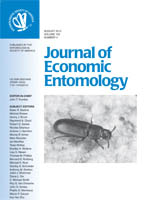The efficacy of toxic baits should be judged by their ability to kill entire ant colonies, including the colony queen or queens. We studied the efficacy of four toxic baits to the Argentine ant, Linepithema humile (Mayr) (Hymenoptera: Formicidae). These baits were Xstinguish that has the toxicant fipronil, Exterm-an-Ant that contains both boric acid and sodium borate, and Advion ant gel and Advion ant bait arena that both have indoxacarb. Experimental nests contained 300 workers and 10 queen ants that were starved for either 24 or 48 h before toxic bait exposure. The efficacy of the toxic baits was strongly influenced by starvation. In no treatment with 24-h starvation did we observe 100% worker death. After 24-h starvation three of the baits did not result in any queen deaths, with only Exterm-an-Ant producing an average of 25% mortality. In contrast, 100% queen and worker mortality was observed in colonies starved for 48 h and given Xstinguish or Exterm-an-Ant. The baits Advion ant gel and Advion ant bait arena were not effective against Argentine ants in these trials, resulting in <60% mortality in all treatments. Because of the strong influence of starvation on bait uptake, control efficacy may be maximized by applying bait when ants are likely to be starved. Our results suggest queen mortality must be assessed in tests for toxic bait efficacy. Our data indicate that of these four baits, Xstinguish and Exterm-an-Ant are the best options for control of Argentine ants in New Zealand.
How to translate text using browser tools
1 August 2012
Influence of Toxic Bait Type and Starvation on Worker and Queen Mortality in Laboratory Colonies of Argentine Ant (Hymenoptera: Formicidae)
Melissa Mathieson,
Richard Toft,
Philip J. Lester
ACCESS THE FULL ARTICLE
It is not available for individual sale.
This article is only available to subscribers.
It is not available for individual sale.
It is not available for individual sale.

Journal of Economic Entomology
Vol. 105 • No. 4
August 2012
Vol. 105 • No. 4
August 2012
boric acid
fipronil
indoxacarb
survival
toxic bait efficacy




